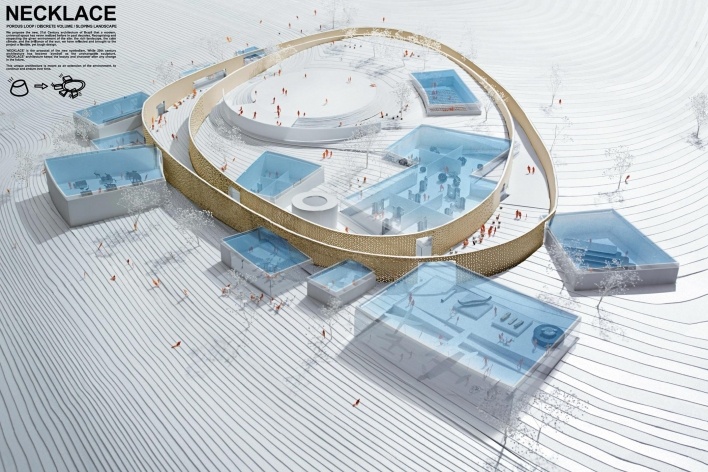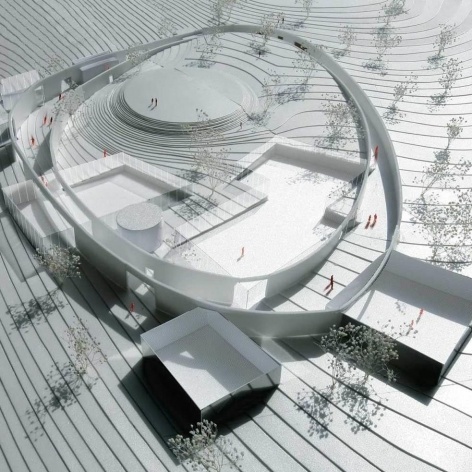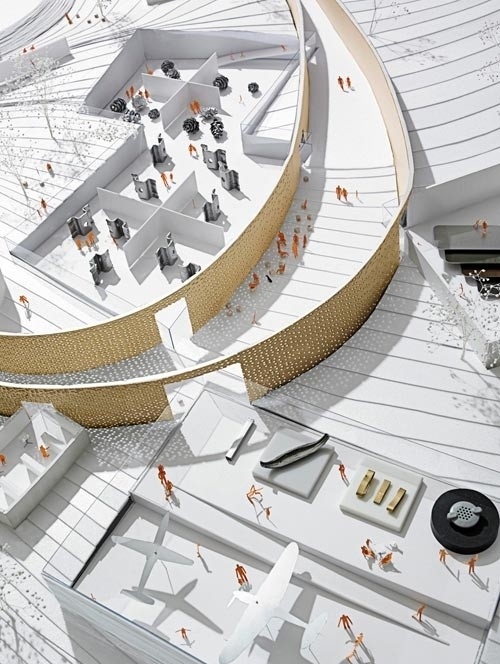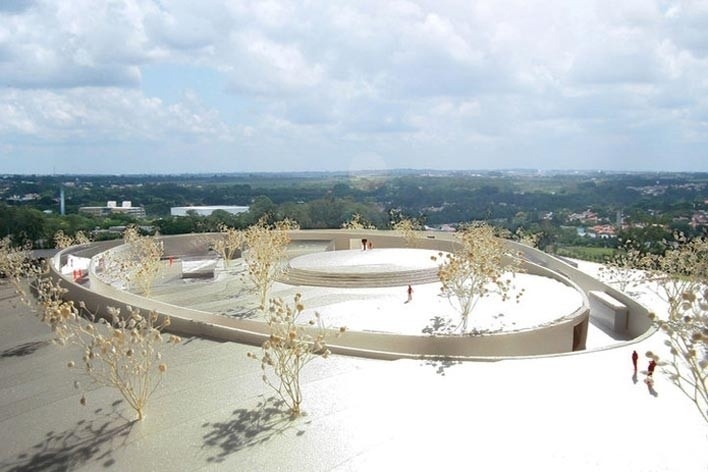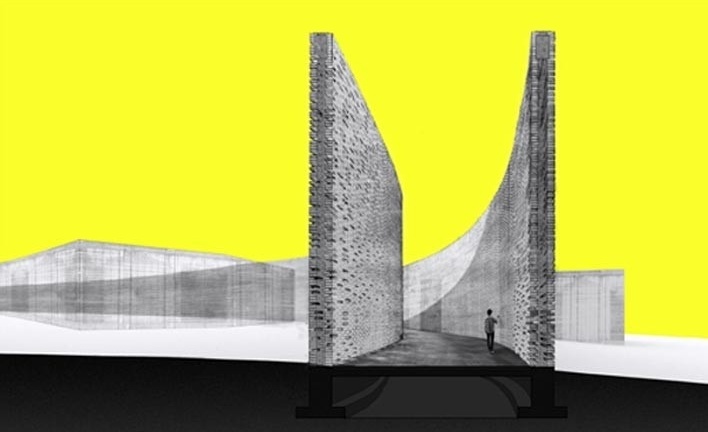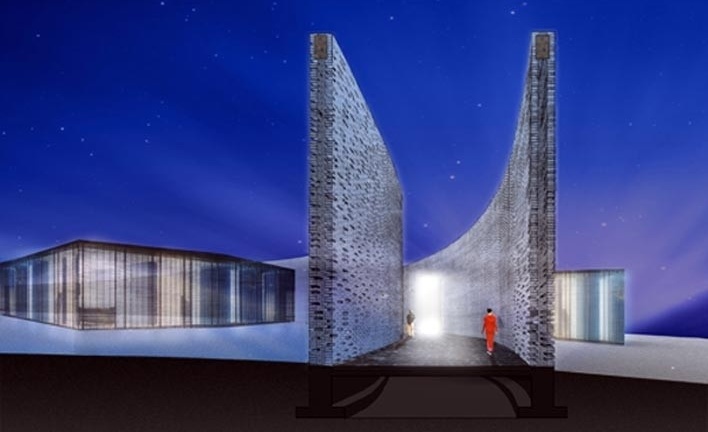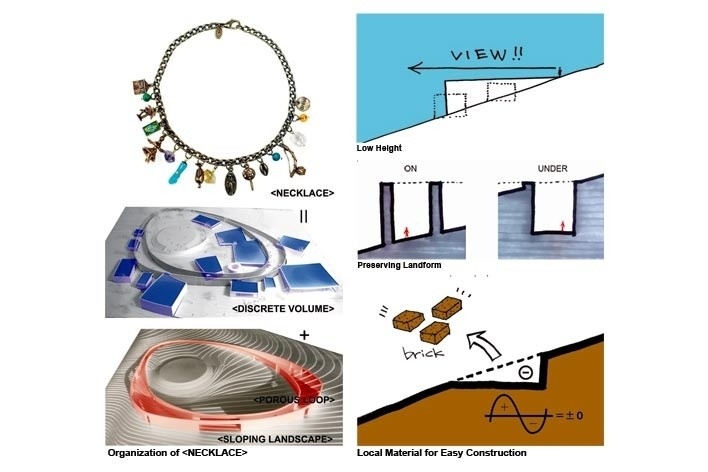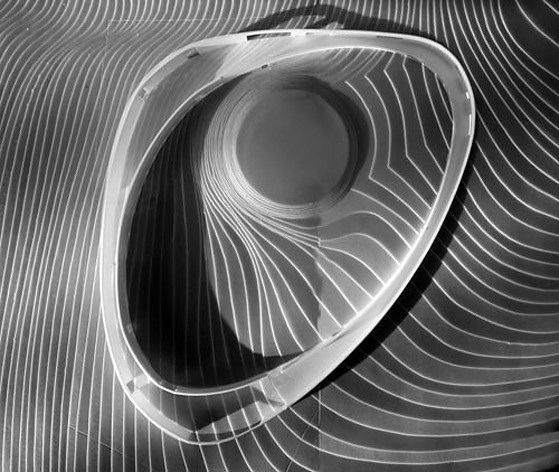In July 2009 Unitydesign, Starburstar and ASA entered a proposal in response to the international public competition, to design an ‘Exploratory Science Museum of UNICAMP’ located on the sprawling hillside campus of the Campinas University in Brazil. Proposals had to work within the strict framework of a limited budget and ecological philosophy which utilized as much low-cost and low-tech projects and materials as possible, without relying on high technology.
Concurso Internacional para Projeto Arquitetônico do Museu Exploratório de Ciências da Unicamp, implantação, 2º lugar. Arquitetos Tomohiko Amemiya, Hiroki Inutsuka e Mitsuru Hamada, 2009
Foto divulgação
21st Century Architecture in Brazil
We proposed a new, 21st Century architectural sense for the design of this project, that utilized the space and environment as had never realized before in past decades in Brazil.
The rich landscape, calm climate, and brilliance of the sun formed the basis of our proposal that focused on sustainability; reducing the reliance on artificial energies such as air conditioning. The unique architectural design was meant to be as an extension of the environment, to mold the structure onto and into the surrounding land, while enduring over time.
Concurso Internacional para Projeto Arquitetônico do Museu Exploratório de Ciências da Unicamp, diagrama de sustentabilidade, 2º lugar. Arquitetos Tomohiko Amemiya, Hiroki Inutsuka e Mitsuru Hamada, 2009
Esquema escritório
We also anticipated that the citizens of Campinas City would want a design that realized their traditional way of life; one that truly co-exists with nature. This project achieves creating comfortable spaces, as nature intended, by using the natural wind and shade, and is effective in also realizing the importance of alternative sustainable energies and architecture for the 21st Century.
Necklace
Our proposal for this project was based upon the concept of the <Necklace>. Our necklace design comprised of the <Porous Loop> or ‘chain’ and had <Discrete Volumes> which represented the ‘jewelry’ or ‘stones’ of the necklace.
Concurso Internacional para Projeto Arquitetônico do Museu Exploratório de Ciências da Unicamp, estudos de "necklace", 2º lugar. Arquitetos Tomohiko Amemiya, Hiroki Inutsuka e Mitsuru Hamada, 2009
Foto divulgação
The double bricked <Porous Loop> wall formed the exterior circulation space between which exhibition spaces were formed. The ‘chain’ concept of the necklace and loop allowed visitors to walk freely around the museum, whilst interacting with the dynamics of the natural environment such as: sunlight, shadows, wind, mist, clouds and sky. In this way, visitors interact wholly and as part of the exploratory science museum’s exterior and interior design. To explore certain exhibitions in more detail, visitors could purchase tickets to enter special exhibition areas, created by the <Discrete Volume> spaces.
This Loop, or the spine of the architecture, was not controlled by electrical energy (air conditioning, ventilation, illumination, dehumidification etc.), but rather simple mechanisms controlled by the environment and managed by the people. This included the flow of natural light or wind, skillfully distributed by the curved porous walls, liberating the architecture itself from a dependence on machines and energy based installations.
The brick walls were made using the soil located on site. Our intention was to realize the space and architecture based on the conventional materials available locally, for easy construction and maintenance. In this way, the architecture would truly be harmonized with the surrounding environment. The brick wall, which represents the primitive elasticity and toughness of Brazil, would also show its beauty with time<Discrete Volumes> representing the closed exhibition spaces, were to be built following the rich landform like houses dotting a primitive village. Each volume had the necessary spec functions and requirements including but not limited to high ceilings, open views, continuity to exteriors, and open spaces. By minimizing the amount of these high spec spaces, our proposal reduced the initial and running costs of the building, and also the environmental impact of machines.
Concurso Internacional para Projeto Arquitetônico do Museu Exploratório de Ciências da Unicamp, diagramas, 2º lugar. Arquitetos Tomohiko Amemiya, Hiroki Inutsuka e Mitsuru Hamada, 2009
Desenhos equipe
The <Neclace> was intended to be a flexible ’system’ of space, under which the shape or size of the space can be determined in the process of discussion (workshop) between the architect and the user. At the same time, this system allows for future changes without losing the function or the beauty of the architecture.
To preserve the dynamic panoramic view from the hilltop location, the <Necklace> was designed to slip into and onto the existing landscape. This meant that half of the Loop was set on the existing landform, while the other half was buried under it; naturally realizing the relational potential to the landscape. The horizontal skyline of the <Porous Loop> as seen from the campus would become the new landmark of UNICAMP, and emphasize the beauty of the sloping hillside.
Science is everywhere around us. Our proposal of the <Necklace> with the exterior circulation space was done so in accordance with our philosophy that the new exploratory science museum should be a space where people could directly learn science from the miracle of the surrounding nature and incorporated architecture, and not just from the exhibits in the room.
Phenomenal Infrastructure – for lasting architecture
Our concepts are to design and realize lasting architectural structures with ‘strong’ spines. This does not mean making things by using eternal materials. Our intention is to realize a strong ‘space’ designed in and responding to, lasting natural phenomena.
We call this concept ‘Phenomenal Infrastructure’, which essentially means designs and architecture realized with sensitively to the movement of the sun, flow of the wind, landforms, and human and natural activity, beyond any ordinal infrastructure that only exists for efficiency.
Our goal is to envision a truly ‘sustainable’ form of architecture not by quantitative measurements but by understanding the special phenomena occurring at each and every site.
Our exploration of the 21st Century sustainable architecture has just only begun.
ficha técnica
Design Architect
Tomohiko Amemiya + Hiroki Inutsuka Unitydesign
Mitsuru Hamada Starburstar
Structural Engineer
Akira Suzuki/ASA
advisers
Equipment Adviser
Kazuhiro Endo/EOS plus
Naohisa Yamashita/Comodo
Lighting Design Adviser
Michiko Yokota and Light
Planning Adviser
Keisuke Kaneko/Engine Architects
Photographer
Sadao Hotta
Translator
Lia Cosco



